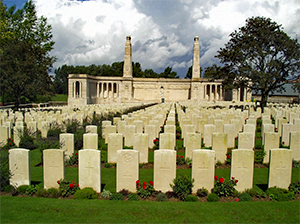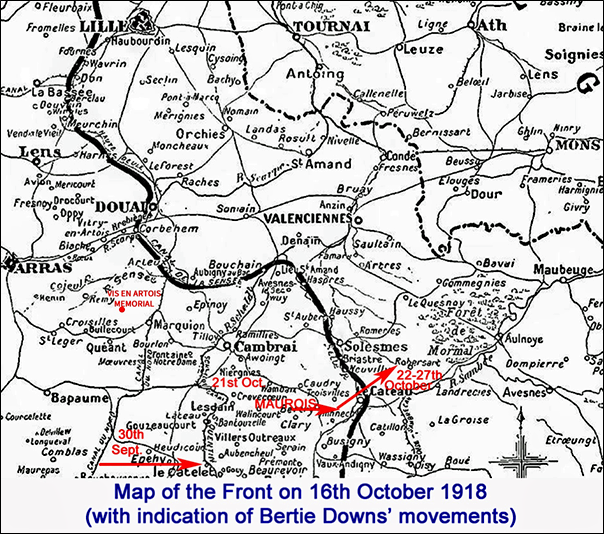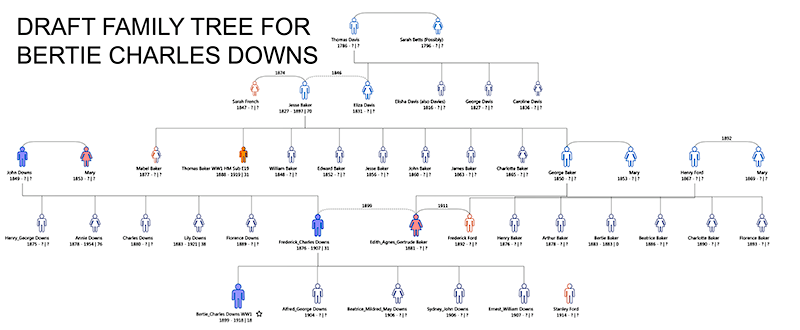First World War Project
Bertie Charles DOWNS (of Teynham)
b. 25th October 1899 Private, Service Number 38847 |

The name of Bertie Downs is one of two late additions to the Teynham Memorial, the other being submariner, Thomas Baker, to whom Bertie was very distantly related through his mother. This early omission may reflect the changes in his family's circumstances following his death.
From medical records, Bertie is described as a healthy agricultural labourer, fresh complexioned, brown hair and eyes. He stood 5 feet 8½ inches tall, with chest measuring 33-5 inches.
Bertie was born on 25th October 1899 in Stone Cottages (near Stone Railway Crossing). He was the oldest of five children to agricultural worker, Charles Frederick and Edith Agnes Gertrude (née Baker). Bertie's younger siblings were Alfred George, Beatrice Mildred May, Sydney John and Ernest William; he had one half-brother, Stanley Ford, from his mother's remarriage in 1911 following the untimely death of Charles at the early age of 31 on 19th October 1907. Initially, this led his mother and her children to move in with her sister (Florence Henrietta) and brother-in-law (Ernest Bridgeland) in Greenstreet. After the 1911 census, but still in 1911 Bertie's his mother married Frederick John Ford, living on Greenstreet Hill. Perhaps the combination of name changes and location may have been enough to break communication between Bertie's mother and the Parish Council and Parochial Church Council as post-war plans for the Memorial unfolded? It wasn't until 6th August 1919 that Bertie's death was confirmed to his mother. He was two days short of his birthday and had served for 152 days after attestation.
Bertie was posthumously awarded the British War and Victory medals. [See Appendix 1]
Military Experience of Bertie Charles Downs
The decision to enlist would not have been straightforward as agricultural production was a priority after years of shortages. However, the pressure on Imperial Forces following the German attacks from March 1918, led to the Military Service Act of 10th April 1918. This reduced the enlistment age for foreign service so that 18½ year old Bertie was able to enlist.
Bertie enlisted into the 4th (Extra Reserve) Battalion, East Surrey Regiment on 25th May 1918. He received his training at Felixstowe for duty with the Harwich Garrison. Four months later, Bertie was posted into the 8th (Service) Battalion, East Surrey Regiment. This "Service" Battalion was one of Kitchener's New Army formations to meet the present needs of war.
Circumstances of the death of Bertie Charles Downs
Bertie landed at Étaples on 21st September when the "One Hundred Days Offensive" was well under way. He was one of 195 recent recruits who were entrained to refresh their Battalion at the Front. During 24th September, Bertie arrived at the Transport lines near the Front during a lull in fighting near Leuze Wood. On that day, the Battalion reported having just lost 21 soldiers, with a further 110 injured or missing. So the new drafts were essential.
On 28th September, the Battalion was bussed to Saulcourt Area, where they relieved the 6th Northants Regiment. It was 29th September that Bertie first say action as the four companies moved off, at 100-yeard intervals, through trenches to their forward positions under some shelling, regarded locally as "quiet". After midday, 30th September, the Battalion moved forward to occupy trenches lying across the head of Macquincourt Valley under heavy shelling and machine gun fire. The intention was to take command of bridges crossing the Canal de St. Quentin but they were held up by stiff German resistance and sniping.
From 1st-2nd October, Bertie and his comrades were relieved back to Liéramont, then by bus and route march to Béhencourt. Between 3rd - 17th October the troops rested, played football, refitted, and reorganized their Platoons and Companies. Heavy artillery was also moved up.

On 17th October, Bertie's Battalion moved to the forward area to join a tactical train at Heilly which took them to Roisel. By route march, early the following day, Bertie marched to Langavesnes where he enjoyed breakfast and dinner before marching off again to Beaurevoir, arriving at 8pm. On 19th October another route march took the Battalion to Élincourt, south east of Cambrai.
During 20th October, Bertie would be part of the final preparation that included fully refreshing arms and munitions, before marching off the next day to Maurois ready for an assault on a heavily defended valley, woodland, villages, farmhouses and river crossing around Bousies and Robersart. Bousies sat astride the main course of the Hirondelle River that provided cover to the German rear-guard.
Bertie lost his life during the next period between 22nd and 27th October after which the Battalion was relieved out of the line.
British heavy artillery was in position to fire directly on positions as directed by the forward observers, rather than laying down a rolling barrage on 22nd October. There were also scheduled 60-pounder bombardments on three key defensive points - the Factory in Bousies, Renault Farm on the road between Bousies and Robersart, and Bousies Wood Farm. Bertie's Battalion was supported by seven tanks. At 11 p.m., the Battalion left Maurois by platoons at 25 yard intervals to arrive at the concentration area for a hot meal - perhaps Bertie's last. Two and a half hours later (23rd October, 1.30 a.m.) the platoons moved off, northeast, at 25 yard intervals towards the jumping-off point on the Fayt Farm Road but their progress was checked so they had to fight their way forward for seven hours to achieve their first objective by 8.30 a.m. Further progress along the road was made under intense machine gun fire and sniping from prepared German positions in Bousies Wood. Under constant fire from light field guns and machine guns the Battalion progressed slowly towards the centre of Bousies village.
Heavy losses were experienced by the 8th (Service) Battalion, their sister West Surrey Battalion (7th Queens) and Northamptonshire Regiments in this attack. They experienced constant strafing, struggling eventually (3 p.m.) to establish forward posts inside the village.
The new line was finally established by 6 p.m. If Bertie was still alive at this stage, he would have experienced 16½ hours continuous fighting. From this action, there were 15 killed, 58 wounded, 16 missing and two reported sick. The night passed relatively quietly. No infantry actions but still sustained enemy suppressing fire, especially around the Factory. By the close of the battle (26th October), the tally was 19 "other ranks" killed, 40 missing, presumed dead, 129 wounded. The 8th Battalion suffered more losses than any other of the East Surrey Regiment - with the exception of the 1st Battalion, which had been serving from the beginning of the War.
An overview of the Battle of the Selle is given by the CWGC, "Though the scene of important British achievements in late October 1918, the actions associated with breaking the line of the River Selle are, comparatively speaking, little known today....the Battle of the Selle appears never to have entered British national consciousness. Objectively, however, it must be regarded as one of the greatest military victories in the nation's history. A total of 1 New Zealand, 2 American and 23 British divisions had engaged 31 (numerically much weaker) German divisions. They had captured some 20,000 prisoners and 475 guns."
Family of Bertie Charles Downs
Additional Documents - possibly recording the untimely death of Frederick Downs
| The Whitstable Times and Herne Bay Herald of 26th October 1907 |
| BOUGHTON UNDER BLEAN. DIED IN HIS SLEEP.- A young man named Frederick Downs, 28 years, a farm labourer, of High Street, Boughton-under-Blean, was found dead in his bed on the morning of the 16th instant. It appears that he came home from work about six on Tuesday evening, as usual, had his tea and went to bed shortly after eight, appearing to be in his usual health. His niece, Alice Downs, who slept in an adjacent room, heard him call out "Oh!" once during the night, but hearing no more, did not go to him. She called him in the morning, but getting no answer went to his room and was startled to find him apparently lifeless. She called a neighbour (Mr. Lucas), who went up and found him dead. Dr. R. Wonnacott, who was sent for, was of the opinion that life had been extinct for some hours, the body being quite rigid. The stomach being extended, he thought that wind round the heart had probably caused failure of the heart's action. The facts being reported to Mr. R.M. Mercer, coroner, he deemed an inquest unnecessary. |
Cautionary Note: There is some difference in the ages we would expect for Bertie Downs' father, so this report is included but with a reserve on whether the report is for the same man.


 World War 1 Pages
World War 1 Pages